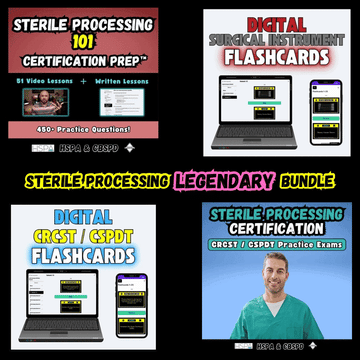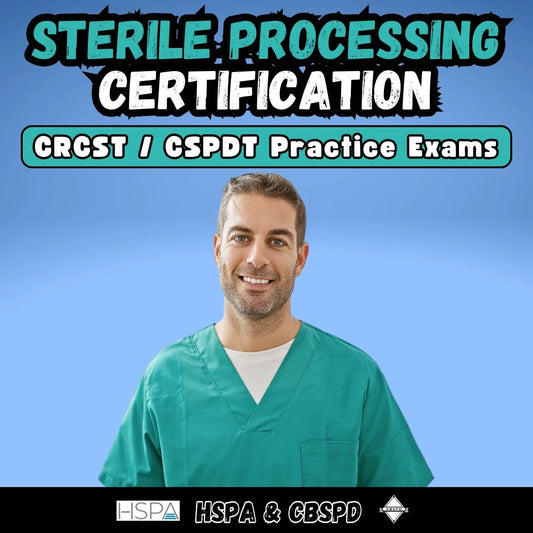Process Challenge Devices: Assessing Sterilization Effectiveness

Ensuring the effectiveness of sterilization processes is crucial in sterile processing departments to maintain patient safety and prevent healthcare-associated infections. To validate the efficacy of sterilization methods, process challenge devices (PCDs) are employed. In this article, we delve into the concept of process challenge devices and their significance in assessing the performance of sterilization processes in sterile processing.
What is a Process Challenge Device?
A process challenge device (PCD) is a specialized test device used to simulate a challenging scenario for the sterilization process that is equal to or greater than the challenge posed by the most difficult-to-sterilize item routinely processed. PCDs are designed to mimic the properties of actual medical devices or instruments while incorporating various characteristics that represent a worst-case scenario for the sterilization method being used. These devices are subjected to the same sterilization process as the load being sterilized, serving as an indicator of the process's effectiveness.
Purpose of Process Challenge Devices
The primary purpose of using PCDs is to challenge the sterilization process by exposing the devices to conditions that are representative of a worst-case scenario. By doing so, PCDs provide critical information about the sterilization process's ability to achieve the desired level of microbial inactivation or elimination. PCDs help identify potential weak points or areas where the sterilization process may be inadequate, ultimately allowing sterile processing personnel to make necessary adjustments or improvements.
Types of Process Challenge Devices
Various types of PCDs are available, each specifically designed for different sterilization methods. Here are a few examples:
Biological Indicators (BIs): BIs are considered a type of PCD that utilizes highly resistant microorganisms, such as spores of Geobacillus or Bacillus species in significant quantities. These microorganisms are placed on a carrier material, which is then subjected to the sterilization process. Following the process, the carrier is incubated to determine if any surviving microorganisms are present. BIs provide direct evidence of the sterilization process's effectiveness and are commonly used for steam, ethylene oxide, and hydrogen peroxide sterilization. BIs can also be paired with other PCD's such as the card pack or a 16 towel test pack created in your department if a prepackaged pack is not available.
Chemical Indicators (CIs): CIs are PCDs that use chemical or physical indicators to assess the achievement of specific process conditions, such as temperature or exposure time. CIs undergo a color change or display a specific pattern when exposed to the sterilization process. They serve as an indirect measure of the process's effectiveness and are commonly used for steam, ethylene oxide, and hydrogen peroxide sterilization.
Bowie-Dick Test Packs: Bowie-Dick test packs are specific PCDs designed to assess the performance of dynamic air removal in steam sterilizers, particularly in pre-vacuum or vacuum-assisted cycles. These packs contain a specific configuration of test sheets and indicators that react to air removal efficiency. The presence of specific color changes or patterns indicates the proper functioning of air removal during the sterilization process.
Importance of Process Challenge Devices
Process challenge devices play a vital role in sterile processing for several reasons:
Validation of Sterilization Processes: PCDs provide evidence that the sterilization process achieves the desired level of microbial inactivation or elimination. They validate the performance of the sterilization method and help ensure that all instruments and medical devices undergo effective sterilization before use.
Identification of Process Weaknesses: By subjecting PCDs to challenging conditions, potential shortcomings or areas of improvement in the sterilization process can be identified. This allows sterile processing personnel to make informed decisions about processes and decisions moving forward.
Having several levels of PCDs to validate a sterilization, and even cleaning process, ensures the highest possible level of patient safety is achieved.
Share
Let customers speak for us
from 243 reviewsI took the practice test and I got a 91% on my certification exam!!
This course was the extra boost that I needed in order be confident in passing the exam. Thank you for all the information provided. I even refer to your notes while working.
Very helpful to me I can study any where at my own pace and low cost than going to school...I'm glad that there is something like this online to help anyone who want to pursue their career as a sterile processing tech.
I loved it, it’s very informative and the questions are great, it’s a great resource to purchase if you want to prepare for your certification exam!
I’ve really enjoyed this course so far. It delivers the information in a straightforward, digestible way. The Sterile Guy has compiled a highly effective program. Thanks very much from one highly satisfied customer!
The practice exams are detailed and easy to navigate. Brandon continues to show his passion in this industry by sharing his knowledge with up-and-coming techs. I also recommend investing in his flashcards. It has helped me greatly. Thank you, Brandon!,
These practice quizzes really helped me get the hang of answering questions related to instruments and the processes of preparing them! I even bought them twice cause I ran out of time lol. Super helpful!
I recently completed the Sterile Processing Guy course online and was extremely impressed. The content was clear, well-organized, and easy to follow. It helped me better understand important concepts like decontamination, disinfection, and sterilization. I appreciated how practical and informative the lessons were, it definitely made studying for certification feel more manageable. I highly recommend this course to anyone pursuing a career in sterile processing!
I won’t lie, I failed the first time around. So I decided to buy this practice test and I passed with flying colors my second go. Highly recommend to anyone interested in the CER, it helped a lot!
The flash card quality is amazing! Bravo sir! The card quality is way above average, questions are great! I’m still learning, utilizing these cards and your practice tests. Thanks for all the info!
I passed the CRCST exam. Taking reg sterile guy practice test over and over definitely helped get the job done.
This certification prep course is a must. Great videos with a lot of information and plenty of of practice exams.
These flashcards are so helpful and well put together. Highly recommend!
I'm really happy that I purchased the SP practice exam. I love how if you answer the question incorrectly, the correct answer will include the page number of the text book to find the answer. The questions are literally based on the textbook. I suggested "The Sterile Processing Guy" to my friend that is studying for the exam as well.








